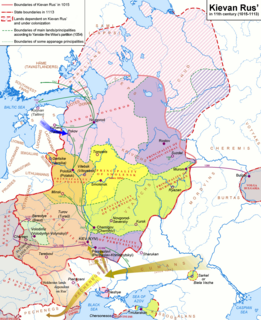
Vladimir-Suzdal, also Vladimir-Suzdalian Rus', formally known as the Grand Duchy of Vladimir (1157–1331), was one of the major principalities that succeeded Kievan Rus' in the late 12th century, centered in Vladimir-on-Klyazma. With time the principality grew into a grand duchy divided into several smaller principalities. After being conquered by the Mongol Empire, the principality became a self-governed state headed by its own nobility. A governorship of principality, however, was prescribed by a Khan declaration (jarlig) issued from the Golden Horde to a noble family of any of smaller principalities.

Rostov is a town in Yaroslavl Oblast, Russia, one of the oldest in the country and a tourist center of the Golden Ring. It is located on the shores of Lake Nero, 202 kilometers (126 mi) northeast of Moscow. Population: 31,792 (2010 Census); 34,141 (2002 Census); 35,707 (1989 Census).

Prince Aleksey Borisovich Lobanov-Rostovsky was a Russian statesman, probably best remembered for having concluded the Li-Lobanov Treaty with China and for his publication of the Russian Genealogical Book.

The Imperial Lyceum in Tsarskoye Selo near Saint Petersburg, also known historically as the Imperial Alexander Lyceum after its founder Tsar Alexander I, was an educational institution which was founded in 1811 with the object of educating youths of the best families who would afterwards occupy important posts in the Imperial service.
Rozhdestvensky Convent, or the Convent of Nativity of Theotokos, is one of the oldest nunneries in Moscow, located inside the Boulevard Ring, on the left bank of the Neglinnaya River. Rozhdestvensky Boulevard and Rozhdestvenka Street owe their names to the convent.
Rostovsky (masculine), Rostovskaya (feminine), or Rostovskoye (neuter) may refer to:
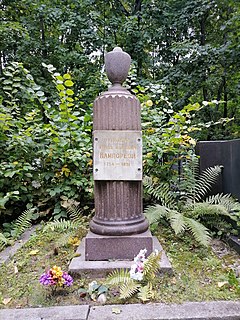
Francesco Camporesi was an Italian architect, painter, engraver and educator who worked in Moscow in 1780s-1820s. Most of his architectural work perished in the Fire of 1812, was severely altered, demolished or otherwise lost.

Ministry of War of the Russian Empire, was an administrative body in the Russian Empire from 1802 to 1917.
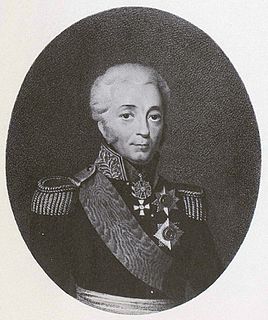
Prince Dmitry Ivanovich Lobanov-Rostovsky was a Russian general and administrator. He stemmed from the Lobanov-Rostovsky family.
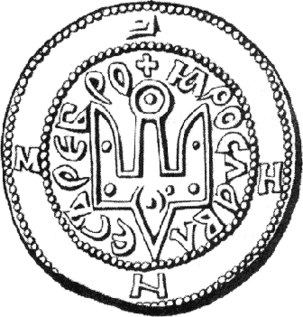
The Rurik dynasty, also known as the Rurikid dynasty or Rurikids, was a noble lineage founded by the Varangian prince Rurik, who established himself in Novgorod around the year AD 862. The Rurikids were the ruling dynasty of Kievan Rus' before it finally disintegrated in the mid-13th century, as well as the successor Rus' principalities and Rus' prince republics of Novgorod, Pskov, Vladimir-Suzdal, Ryazan, Smolensk, Galicia-Volhynia, Chernigov, and the Grand Duchy of Moscow.
Yakov Lobanov-Rostovsky may refer to:
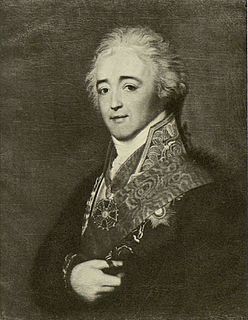
Prince Yakov Ivanovich Lobanov-Rostovsky was a Russian statesman.
Prince Yakov Lobanov-Rostovsky was a Rurikid prince of the Lobanov-Rostovsky family and Russian statesman and civil servant.
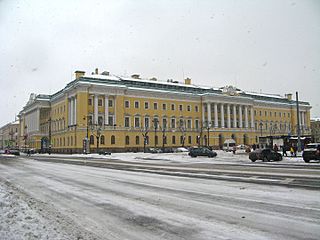
Lobanov-Rostovsky Residence or the Lobanov-Rostovsky Palace is a building at 12 Admiralteysky Avenue in Saint Petersburg, Russia, constructed in 1817-1820 for Prince Alexander Yakovlevich Lobanov-Rostovsky. Today, the building houses a luxury hotel in the Four Seasons Hotels and Resorts chain, under the name of Four Seasons Hotel Lion Palace, referring to the two Medici Lions at the main entrance.

Prince Nikita Dmitrievich Lobanov-Rostovsky, known as Nikita Lobanov, is a Russian Rurikid, geologist, banker, and notable art collector of Russian stage design of the period of 1880–1930.
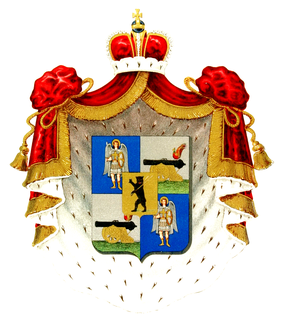
Shakhovskoy is the name of a princely Russian family descending from the Rurik Dynasty, and as such, one of the oldest noble families of the Russian Empire. Most members of the family fled the Russian Empire in 1917 during the Russian Revolution.
Monomakhovichi or House of Monomakh was a major princely branch of the Rurik dynasty, descendants of which managed to inherit practically all princely titles in the Grand Duchy of Kiev. The progenitor of the house is Vladimir II Monomakh. The name derived from the grandfather of Vladimir, Constantine IX Monomachos.
Lobanov is a Russian masculine surname, its feminine counterpart is Lobanova. It may refer to:
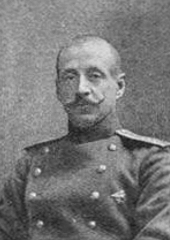
Viktor Petrovich Taranovsky was a Russian Major General of the First World War. He served in the Lithuanian Life Guards Regiment of the Russian Imperial Guard and from 1916 commanded the Russian division on the Macedonian front. After the October Revolution his division was largely interned, though some volunteered to fight on the French front. Taranovsky remained in France as a white émigré serving on veterans committees and as assistant rector at the Alexander Nevsky Cathedral, Paris.













